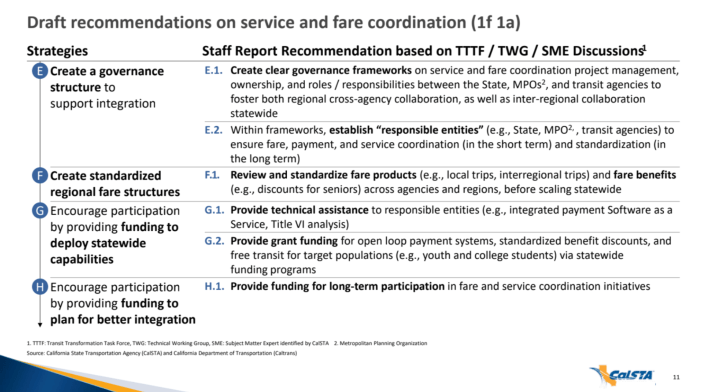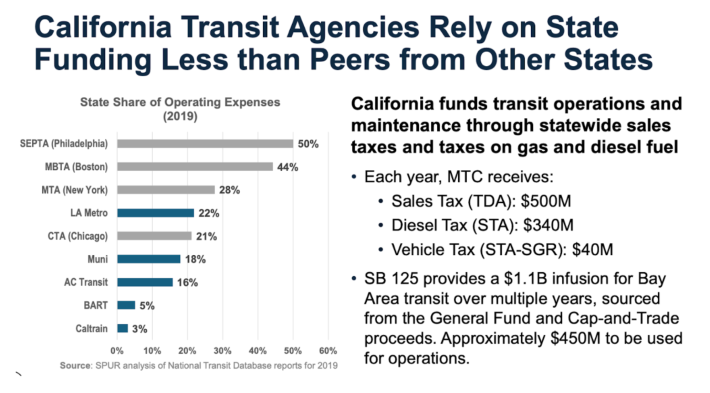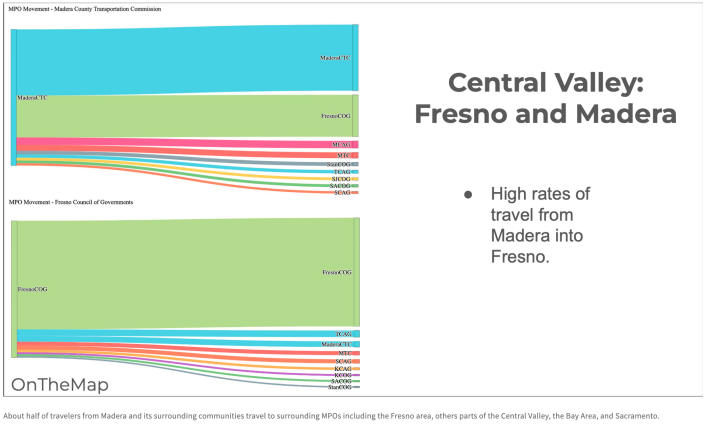On Monday, October 28, the State Transit Transformation Task Force (TTTF) considered adopting recommendations to support coordination of fares and schedules across agencies within regions, and for interregional trips, as part of an overall strategy to improve rider experience and increase ridership.
Representatives of transit agencies pushed back, raising worst-case scenario objections that policies to support a seamless transit experience would induce legislators to see them as a substitute for current state funding, and that they would require agencies to make nonsensical choices that wouldn’t increase ridership. Staff withdrew the recommendations and will bring revised versions back at an upcoming meeting.
Seamless Bay Area strongly supports these recommendations. Evidence around the world shows that such measures increase ridership and lead to an increase, rather than a decrease, in public funding for transit. We also support emphasizing that funding for service is a prerequisite for seamless transit. And we support adding recommendations to conduct regional business cases and equity analyses to ensure that regions prioritize worthwhile and equitable coordination initiatives, and to determine the appropriate boundaries of regional coordination.
It will be important for riders to speak up to communicate about how well-coordinated, affordable service improves people’s lives and removes barriers to using transit. Seamless Bay Area will post about opportunities to speak up in the coming months.
State Task Force Debates Seamless Transit Recommendations
The California Transit Transformation Task Force (TTTF) was set up by state budget legislation (S.B. 125) in 2023. S.B. 125 provided temporary funding to keep transit running, and also set up a two-year process to generate recommendations for long-term funding and policy reforms, with goals including increasing transit ridership to achieve the state’s climate goals. Members on the task force include agencies, stakeholders from business, labor, and advocacy groups, academics and experts.
Despite substantial discussion about the importance of fare and service integration at the last TTTF meeting, with supporting evidence of impressive ridership gains in other parts of the world, several task force members representing transit agencies led an effort to remove key recommendations from consideration.
Sharon Cooney, CEO of San Diego Metropolitan Transit System, made the case against them, claiming that the policy recommendations related to establishing governance structures to support integration within each region of California (see table below, E1 and E2) could do more harm than good. She introduced a motion, seconded by California Transit Association Executive Director Michael Pimentel, to strike these recommendations.

Cooney argued that recommendations to coordinate service would be viewed as a ‘panacea’ by legislators, and distract from the need for additional operations funding.
The example of Switzerland in particular counters the argument that recommendations to integrate service and fares would undermine the case for additional operations funding. In Switzerland, such policies and the governance that enabled them helped build broad support for additional funding for transit, and have since contributed to a ‘virtuous circle’ of increased ridership, coordination, and investment.
Prior polling on regional funding measures conducted by the Metropolitan Transportation Commission (MTC) and Seamless Bay Area/Beneficial State Foundation has indicated that integration is among the most popular arguments for additional funding.
Recommendation E1 calls for creating clear governance frameworks defining roles and responsibilities among the state, Metropolitan Planning Organizations, and agencies to foster cross-agency collaboration, and Recommendation E2 recommends the establishment of a ‘responsible entity’ within each region.
These steps are essential success factors for regional integration, according to research from the Mineta Transportation Institute, last year’s Bay Area Transit Professional Delegation to Switzerland, and Seamless Bay Area’s 2023 webinar on European models for transit integration.
Following Cooney’s comments, task force members Juan Matute of UCLA, Laura Tolkoff of SPUR, and Ian Griffiths encouraged rewording the recommendations to focus on a shared process to identify roles and responsibilities, rather than the language of “governance” which CalSTA staff identified as “triggering.” Task Force chair Mark Tollefson introduced a motion for CalSTA staff to rework the recommendations and bring the item back for consideration at an upcoming meeting.
Notably, Cooney, Pimentel, and three other task force members voted against Tollefson’s compromise motion.
The draft recommendations also included other provisions supporting the coordination of fares and schedules. These include standardizing fare types across agencies within regions first - before any statewide effort - and providing state funding to develop and fund integrated, affordable fare systems. They also include developing standards, guidance and data, technical assistance, tools, and funding to help coordinate schedules.
Transit agencies responded using several logical fallacies and worst-case scenarios to argue against fare and schedule coordination. Michael Pimentel of the California Transit Association asserted that improving service frequency would eliminate the need for schedule coordination.
It is true that in dense urban areas, major lines with very frequent service do not need to be coordinated. Chad Edison of CalSTA observed that integration is particularly important where service is not frequent - where it comes only every half hour or hour. Even in San Francisco, headways of twenty minutes and longer are still to be found, and California has many urban, suburban, exurban, and rural lines with frequencies of twenty, thirty, and sixty minutes or even less frequent. Even in European regions with much higher levels of per capita operating funding than in California, there remain suburban and rural lines with infrequent service that need coordination.
The amount of funding needed to bring all transit lines in California to ten-minute service is exceedingly high, and there is no plan or timeline for such a scenario. In the foreseeable future, regions using international good practices can use judgment about which lines to coordinate and thereby dramatically reduce trip times.
Seamless Bay Area’s 2023 webinar with Thomas Geier of Vienna’s regional transport authority articulated this principle clearly. In describing the Vienna region’s approach to coordinated schedules, he explained that “when you have lower frequencies, local agencies must abide by the integrated planning of the region's needs so that riders have proper connection… The lower the frequency, the more important is the integrated regional planning of services.”
Agency task force members raised concerns that schedule coordination policies might be applied in an unreasonable manner. Examples included requiring agencies to coordinate with intercity service that runs on freight lines and are therefore very unreliable, with hour-long delays common; or requiring a rural area to frequently change its schedule to match an urban area with more frequently changing routes.
In approaching coordination within each of California’s regions, the planning for service coordination should use data to inform which lines should be coordinated, taking into account costs and benefits. Extremely unreliable lines would not be chosen for coordination. Data about how unreliability impacts trip times can be used in the long term to plan and help justify reliability improvements that range from transit priority for buses and light rail, grade separations, and strategies to disentangle passenger and freight rail. Proposals about connecting urban and rural areas would be made with cost-benefit in mind.
Funding for Service Is Paramount
Seamless Bay Area has long supported the need for more operations funding for transit, and we agree with agencies that identifying new operations funding must be a key priority of the Task Force. Fare and schedule coordination cannot substitute for running service.
California underfunds transit operations compared to other regions in the U.S. and around the world that have robust transit, as analysis from SPUR shows (see below). Recommendations from the task force should clearly state that funding is paramount and coordination is a complement, not a substitute. At the same time, policies like fare and service integration help build support for new funding, and can ensure that new money will bring a greater benefit in building ridership.

Not One-Size-Fits-All
Seamless Bay Area strongly supports the staff recommendations to advance fare and schedule coordination, including clarifying the institutional arrangements needed to coordinate. We encourage refining the language of the recommendations to make very clear that the intent and the policy is to guide changes pragmatically to benefit riders and ridership.
Several agency representatives expressed concern that what was being proposed amounted to a “one-size-fits-all” mandate. But the need and benefit for coordination varies depending on the type of trip and the needs of the region.
For some locally focused routes, riders use few transfers and schedule coordination is not needed. For regional trips, coordinated feeder service is often very helpful to make travel competitive with driving, especially in regions with multiple agencies. For long-distance trips, connecting service might be valuable (if the long-distance service is sufficiently reliable), but fare coordination might be less needed if the first mile is a small share of the overall trip cost.
Equity analysis is also needed to assess whether fare coordination would significantly increase mobility for low-income populations, and whether proposed changes would provide fair benefits to communities dependent on transit. In general, benefits are greater in regions with multiple agencies where trip patterns cross agency boundaries.
Regardless, every region benefits from clearer definitions of roles and responsibilities with regard to integration in order to be able to investigate a fitting approach to coordination.
The state task force may also wish to recommend, and provide funding for, a business case review including equity assessments to prioritize what sorts of coordination may be of greatest value, and then to make informed decisions about how to advance coordination. Such assessments can defuse the arguments against the red herring of a one-size-fits-all solution. The process should include riders, as our experience is that the needs and preferences of riders can differ from the conventional wisdom among operators, and can reveal opportunities for changes that increase ridership.
Pilots can be helpful. In the Bay Area, some agencies were skeptical about the demand for fare coordination, and the BayPass all-agency transit pass pilot showed a large - forty percent - ridership increase across agencies.
Clearer Definition of ‘Travel Regions’ Could Help Build Support for Integration
One observation and lesson is that the Bay Area has already made significant progress in exploring and advancing coordination. Thanks to concerted advocacy from riders, including Seamless Bay Area, MTC led a fare coordination and integration study in 2019, and conducted a Blue Ribbon Task Force that created a Transformation Action Plan to coordinate transit in 2021.
Because of this groundwork, the Bay Area is well-positioned to take advantage of technical support and funding, and positioned to react to these recommendations with eagerness rather than fear.
Seamless also observes that some angst around the topic of transit coordination may be related to the fact that ‘regions’ are often not well-defined in California. A recent analysis conducted by recent Stanford graduate Kohi Kalandarova and supported by the Bill Lane Center for the American West at Stanford University indicated that California’s Metropolitan Planning Organization boundaries are not always the most sensible boundaries for coordinating transit. In the Bay Area, the majority of travel is within the MTC’s boundary, so it makes sense to assess coordination opportunities within these boundaries.
But in the Central Valley, the MPO may not be the right planning region, and many of the MPOs currently play little role in transit. The student research showed that there are high rates of travel between Madera and Fresno, for example, so a coordination plan might need to cross those regional boundaries. On the other hand, the Southern California MPO region, SCAG, is enormous, and there are smaller travel sheds that might be reasonable boundaries for coordination.
A first step in planning for coordination should be to verify the area where it makes sense to coordinate. Seamless Bay Area has recommended that the Task Force staff conduct data-driven analysis of travel behavior within the state to identify the travel regions that would yield the greatest benefits from coordination. Such an analysis would help ensure that coordination is being pursued as a policy solution in those situations where it can have the greatest impact, rather than applying a one-size-fits-all approach to coordination across the state.

Conclusion
Statewide policy, funding, and technical assistance for fare and schedule coordination initiatives have significant potential to improve rider experience, increase ridership, and support the state’s climate and equity goals. These initiatives benefit from clearly identifying regionally appropriate roles and responsibilities of the parties working together to advance this coordination.
These measures are not a substitute for funding, but are a complement to enable funding to go further to create better transit. We encourage staff to refine the recommendations to make clear that funding is paramount, to clarify the state’s transit coordination regions based on a data-driven analysis, to craft updated recommendations to clarify roles and responsibilities for regional integration within each region, and to encourage regional business case studies, including equity assessments, to identify areas to focus on and carry out the desired initiatives. These processes should include riders speaking to how agencies can support travel needs.
A few of the task force recommendations were adopted, including those that address safety and cleanliness standards. These are considered preliminary recommendations for further discussion, and they include things like developing safety standards and equipment, increasing the use of safety ambassadors, and allowing transit agencies to be eligible for funding that supports unhoused people. More details on those can be found in the meeting presentation slides.
Although last week’s meeting did not yet lead to adopting recommendations on coordination, the robust discussion may prove valuable in forging consensus around a full set of task force recommendations that address an acceptable path forward for all stakeholders - delivering a strong case for additional funding, with the transformational policy reforms that can ensure that new funding leads to the greatest possible impact in building ridership.

Note: This post was previously published on Seamless Bay Area's blog.






